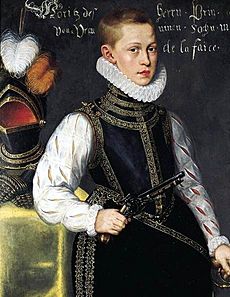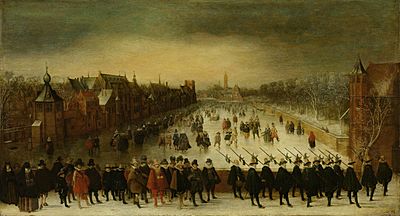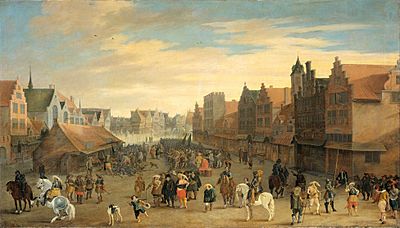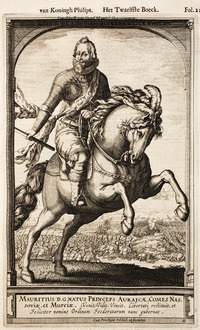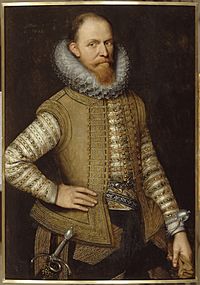Maurice, Prince of Orange facts for kids
Quick facts for kids
Maurice of Orange
|
|
|---|---|
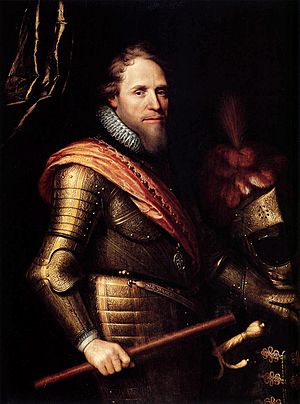
Portrait by Michiel Jansz. van Mierevelt, 1607
|
|
| Prince of Orange | |
| In office 20 February 1618 – 23 April 1625 |
|
| Preceded by | Philip William |
| Succeeded by | Frederick Henry |
| Stadtholder of Holland and Zeeland | |
| In office 14 November 1585 – 23 April 1625 |
|
| Preceded by | William the Silent |
| Succeeded by | Frederick Henry |
| Stadtholder of Utrecht, Guelders and Overijssel | |
| In office 1590 – 23 April 1625 |
|
| Preceded by | Adolf van Nieuwenaar |
| Succeeded by | Frederick Henry |
| Stadtholder of Groningen | |
| In office 1620 – 23 April 1625 |
|
| Preceded by | William Louis |
| Succeeded by | Ernst Casimir |
| Personal details | |
| Born | 14 November 1567 Dillenburg, County of Nassau, Holy Roman Empire |
| Died | 23 April 1625 (aged 57) The Hague, County of Holland, Dutch Republic |
| Resting place | Nieuwe Kerk, Delft, Netherlands |
| Parents |
|
Maurice of Orange (Dutch: Maurits van Oranje; 14 November 1567 – 23 April 1625) was an important leader in the Dutch Republic. He served as a stadtholder (a kind of governor) for most Dutch provinces from 1585 until his death in 1625. He became Prince of Orange in 1618 after his older half-brother, Philip William, passed away. Before that, people knew him as Maurice of Nassau.
Maurice grew up in Dillenburg and studied at universities in Heidelberg and Leiden. He took over his father's role as stadtholder of Holland and Zeeland in 1585. Later, he became stadtholder of other provinces like Utrecht, Guelders, Overijssel, and Groningen. As the main commander of the Dutch army and navy, Maurice played a key role in the Dutch Revolt against Spain. He was a brilliant military strategist.
Working with Johan van Oldenbarnevelt, a leading politician, Maurice led the Dutch States Army to many victories. They pushed the Spanish forces out of the northern and eastern parts of the Republic. Maurice also brought new ideas to military training and tactics. During a break in the war, called the Twelve Years' Truce, a religious disagreement led to a serious conflict between Maurice and Van Oldenbarnevelt. This conflict ended with Van Oldenbarnevelt's arrest and death. After the truce ended, Maurice faced more challenges in the war. He passed away in The Hague in 1625 and was succeeded by his younger half-brother, Frederick Henry.
Contents
Early Life and Education
Maurice was born at the castle of Dillenburg. His parents were William the Silent and Anna of Saxony. He was named after his grandfather, Maurice of Saxony, who was also a famous general.
Maurice was raised by his uncle, Johan of Nassau, in Dillenburg. He studied at Heidelberg and Leiden with his cousin, Willem Lodewijk. The provinces of Holland and Zeeland paid for his education. This was because his father had spent all his money fighting in the early stages of the Dutch revolt.
Maurice was only 16 when his father was killed in Delft in 1584. Soon after, he was appointed to his father's important role as stadtholder. He became stadtholder of Holland and Zeeland in 1585. Later, he also became stadtholder of Guelders, Overijssel, Utrecht, Groningen, and Drenthe.
Maurice was a Protestant. His older half-brother, Philip William, Prince of Orange, was a Roman Catholic and the Prince of Orange before him. However, Philip William was held captive by Spain for many years. This meant he could not lead the Dutch fight for independence.
Military Achievements
Maurice transformed the Dutch Revolt against Spain into a strong and successful movement. He worked with Willem Lodewijk to reorganize the Dutch States Army. He studied military history, strategy, and tactics. He also learned about mathematics and astronomy. These studies helped him become one of the best military leaders of his time.
The Eighty Years' War was a big challenge, but Maurice proved himself. He was especially good at sieges, which means surrounding and capturing enemy towns or forts. He captured many important places during a period known as the Ten Glory Years. These included Breda in 1590, Zutphen in 1591, and Groningen in 1594. By 1597, he had captured many more towns, like Groenlo and Lingen.
These victories helped to define the borders of the Dutch Republic. They made the revolt stronger and allowed a new nation to grow safely. Maurice became known as the leading general of his era. Many future great generals learned their skills by serving under him.
Maurice also won important battles like Turnhout (1597) and Nieuwpoort (1600). In these battles, his cavalry (soldiers on horseback) played a big part. These wins brought him fame across Europe.
Maurice also focused on training his army. He believed that regular drills and exercises were key to good tactics. This was a new idea for armies at the time. It meant officers had to train their soldiers, not just lead them. Soldiers also needed to be more independent and smart. One of his big ideas was volley fire. This is when a large group of soldiers fire their weapons at the same time. It helped make up for weapons that weren't very accurate. This tactic was first used in Europe at the Battle of Nieuwpoort in 1600.
Maurice was known as the best general of his time. His fame came from his skill as a siege commander and his ability to organize and innovate the military. He created a new way of military training. This helped lead to the professional armies we know today. Many commanders who served under Maurice, like his nephew Marshal Turenne, used his ideas with great success.
Political Challenges
Maurice initially worked closely with Johan van Oldenbarnevelt, a powerful politician. However, tensions grew between them. Van Oldenbarnevelt decided to sign the Twelve Years' Truce with Spain, which lasted from 1609 to 1621. Maurice disagreed with this decision. They also argued about money for the army and navy, and how the war should be fought.
A religious conflict between two groups, the Gomarists and the Remonstrants, made the struggle between Maurice and Van Oldenbarnevelt even worse. This conflict ended with Van Oldenbarnevelt's arrest and death. From 1618 until his own death, Maurice had complete power over the Dutch Republic. He also became the Prince of Orange in 1618, a title he did not use very often.
Maurice encouraged his younger half-brother, Frederick Henry, to marry. This was important to continue their family line.
Later Years and the War
Some historians believe Maurice played a part in starting the Thirty Years' War. This war caused great destruction in Germany. Maurice encouraged his nephew, Frederick V, Elector Palatine, to accept the Bohemian Crown. He also supported the Bohemians in their fight against Habsburg rule. He sent them money and Dutch troops. This decision had very bad results for the Bohemians and for Frederick. It also made the Dutch Republic's own position more difficult.
In 1621, the war with Spain started again after the 12-year truce. The Spanish, led by Ambrogio Spinola, had some important successes. One of these was the Siege of Breda, which was an old family home of the Nassau family.
Maurice passed away on 23 April 1625, while the siege of Breda was still happening. Justin of Nassau surrendered Breda to the Spanish in June 1625, after a long and costly siege.
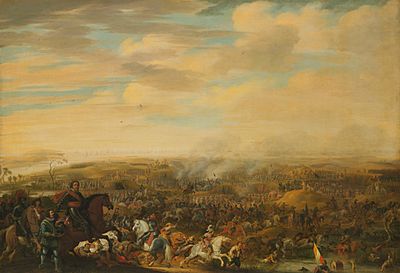
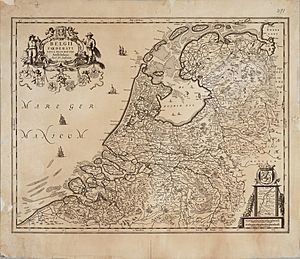
Key Battles
Maurice was the main commander for the Dutch forces in many battles and sieges. Here are some of them:
- Axel
- Breda, 1590
- Zutphen, 1591
- Nijmegen, 1591
- Steenwijk, 1592
- Coevorden, 1592
- Geertruidenberg, 1593
- Groningen, 1594
- Turnhout, 1597
- Groenlo, 1597
- Nieuwpoort, 1600
- Ostend, 1601
- Siege of Sluis (1604)
- Bergen op Zoom, 1622
- Breda, 1624
Places Named After Maurice
- The island nation of Mauritius, in the Indian Ocean, was named after him. Dutch explorers named the island in his honor in 1598.
- In 1611, the Hudson River in North America was sometimes called the Mauritius River or Mauritz River, also in his honor.
Titles and Coat of Arms
Maurice was the stadtholder of several provinces and the Captain-General of the army. These were appointed roles, not passed down through family. However, he was also the hereditary Prince of Orange, a sovereign (ruling) prince of a small area in France called Orange.
He also held many other important titles and owned many estates, which made him very wealthy. Some of his titles included:
- Marquis of Veere and Vlissingen
- Count of Nassau-Dillenburg, Buren, and Leerdam
- Viscount of Antwerp
- Baron of Breda, Eindhoven, and Grave
He continued to use the same coat of arms as his father throughout his life.
Images for kids
See also
 In Spanish: Mauricio de Nassau para niños
In Spanish: Mauricio de Nassau para niños


